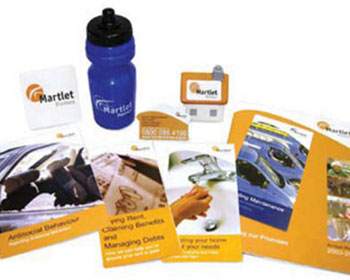


You're starting a business...and you know you that getting the word out about your business through effective marketing is the only thing that's going to bring in the customers and sales. But where to start, and how to prevent marketing costs from getting out of control?
The good news is that the most important parts of marketing are completely free, and the even better news is that theres a strong likelihood that – surprisingly – many of your competitors wont have exploited these critical keys to successful marketing. Investing the time to focus on these seven areas will pay huge dividends when it comes to implementing ongoing marketing activities for your fledgling business.
Step 1. Know where you want to go
Its easy to fall into the trap of having a business idea and going ahead with it without really thinking about exactly where you want to take it (I know because Ive done it myself in the past!). You can very quickly get carried away with the idea of running a business and not concentrating on planning the business on a higher, strategic level. Before you know it, youre too busy working on the details of your business to see the bigger picture and take stock of where you are.
So whatever stage of business youre at, take the time to work out exactly where you want the business to go. As the saying goes, if you dont know where youre going, any road will take you there...and you may just find that the place you end up just isnt where you really want to be. Having goals and objectives for the future of your business is one of the most important factors for creating a business that will help you realise your own personal concept of success.
Step 2. Know your customers
You simply cant market your business effectively unless you first know exactly who you want to talk to. Understand that "everyone" is never a viable target market, so make sure you have a very clear picture of your ideal client before you start any marketing at all.
For example, a virtual assistant (VA) working from home might want to target SMEs in the business-to-business sector, with between 5 and 20 employees, within a 20-mile radius of her base. Or, as VAs arent necessarily bound by a specific geographic area, she might decide to focus on a specific niche (such as professional speakers or business coaches, for example) and offer a targeted range of services tailored to the needs of that specific group.
Your decision as to which target market to focus on will likely be based on your own preferences, experience and skillset. Whichever target group you choose, theyll need to have four things in common to be viable prospects for you: a specific need, access to your product or service, enough money to buy it and the authority to make the buying decision.
Once youve established those four things in your ideal target market, create a clear profile of your ideal customers. This profile could include things such as their likes, dislikes, location, age, family situation, business type and size, what they read, where they can be found online, problems that keep them awake at night, etc.
Step 3. Competitive advantage
You need to know exactly why people should want to do business with you instead of the many other options your target market is presented with. The harsh reality is that if youre not 100% sure why somebody should buy from you, your customers wont be either.
So create at least one clear differentiating factor in your business that will make you the more appealing choice in relation to your competitors. (Note that Ive called this your competitive advantage, not your USP or Unique Selling Proposition; these days its pretty tricky to be completely unique, so simply focus on establishing something that makes it easy for your customers to choose you over anyone else.)
Here are some questions to get your ideas flowing as to what your competitive advantage could be:
- Do you or your business have any special expertise, credentials or awards?
- Do you have any specific abilities in the areas of production, delivery, your product lines, quality, your guarantee or pricing?
- Do you make it easier for your customers to do business with you thanks to free/reduced-cost introductory consultations, more information, bonuses and incentives, better terms, longer hours, better customer service and follow-up?
- Is your customer service better than the competition? (E.g. more value added service, volume discount pricing, special systems for resolving customer complaints, more information and longer-term relationships with customers)
Once you have narrowed down a couple of key ideas, prioritise them in order of importance and relevance to your customers, then write out a short paragraph clarifying and describing what your competitive advantage is. Getting this down in writing will really help to focus your efforts, and youll be able to refer to this in any marketing that you undertake.
Step 4. Know your marketing message
Whenever you do anything to promote your business, always consider things from the customers perspective. For example, you need to be able to clearly describe the benefits you offer customers, who only care about "whats in it for me". Make a list of the features of your products and services, then convert those features into benefits to the customer by asking yourself which means that... until you reach the ultimate benefit that your customers receive. Also consider the pressing problems that your customers experience and which are resolved by using your product or service. Remember that even for business purchases, people tend to buy for emotional reasons, then justify their decision with logic.
When working on your benefits list for your business, bear in mind that the top ten motivators are: saving time, saving money, making money, avoiding effort, increasing happiness, finding success, being pain free, having fun, feeling safe and secure, and feeling liked or loved.
All the answers you come up with here will be hugely valuable when it comes to getting a compelling marketing message across to your best potential customers. So its worth investing the time on this to create a powerful list of reasons for your ideal customers to buy from you.
Step 5. Have a plan
Marketing is most definitely not about taking action when you can fit it in between other business activities. To get the best results, you need to move beyond hit or miss actions and develop a deliberate, systematic approach, ideally setting aside specific times each week to work on marketing.
Your marketing plan doesnt have to be a 50-page epic, though. Use whatever format works best for you. I recommend creating a practical, short document that you can easily refer to and use.
Things to include on your plan could be:
Specific, measurable goals, your marketing message (benefits to the customer), a description of your target market and ideal customer, your competitive advantage, action steps to follow with target dates for completion, financial objectives/budget, and last but not least, tracking mechanisms: Without measuring your progress, its easy to waste time and money and get discouraged. Your plan must include ways of measuring how you are progressing towards your stated goal(s).
Step 6. Use low-cost marketing techniques
There are literally dozens of free and low-cost marketing tools that you can use to get the word out about your business.
Here is a choice selection of just five top low-cost marketing techniques:
Online article and press release distribution services – Build credibility, create valuable inbound links to your website, and potentially spread the word far and wide, by writing and submitting useful articles relating to your business and/or target market. Two great places to start submitting your articles are ezinearticles.com and prweb.com, but search on the web and youll find plenty more.
Referrals – This technique alone has the potential to double your customer base in a relatively short space of time. Recommendations from people we know and trust are hugely powerful, and leads generated from referrals have very high conversion rates. If youre starting out and youve only just got your first customer, do everything you can to make them a happy customer and ask for five referrals (you might not actually get the full five, but youll probably get more than the usual one referral). Use an ethical bribe if appropriate, and above all; dont stop asking!
Fusion marketing – Create marketing alliances with non-competing businesses serving the same target market as you. Send endorsements of one anothers services to each others lists, hand out flyers or discount cards to one anothers customers....the options are many and varied, so get creative and start making proposals to likely partners.
Networking - Remember to be targeted in the events that you go to, and bear in mind that its not about handing out as many business cards as you possibly can, but rather about creating and nurturing relationships.
Testimonials / case studies - Nothing beats genuine endorsements from third parties in building trust and credibility in what youre offering to the marketplace. We might not like to admit it, but we tend to have a herd mentality and we want to know that others have benefited from a product or service already. So dont be afraid to ask your customers for feedback and comments, and always ask for permission to use favourable customer comments. And if you havent yet started trading, look to people who can comment on you or your services from a previous job, business or voluntary position.
Step 7. Avoid being a one-hit wonder
Research shows that your customers and prospects need to hear from you seven to ten times before they really hear what your message is and respond. The bad news is that most companies I encounter do not have a follow up strategy at all. Most people follow up two or three times at best, and then stop. Remember to focus on this seven to ten rule and create a strategy for following up with your potential customers multiple times, with messages that are useful and relevant to them.
Most of all, remember to keep in touch with your best customers on a regular basis...youve no doubt already invested considerable time and money in acquiring that customer, so dont let that go to waste. Set up a system for keeping in touch with existing clients by whatever means are appropriate.
Follow these seven basic principles in your business always...and youll be well on your way to marketing utopia in no time.
by Louisa Bird, Womens Marketing Forum
Louisa is a small business marketing coach and author. She is also the Founder of the Womens Marketing Forum – the online community for women who want to increase their skills and confidence in marketing their business using practical, low-cost methods.





As we cannot be experts in every relevant subject, we would love to receive 'guest' articles that may be of interest to anyone running their own business or thinking of doing so. ADD YOUR ARTICLE
